In world football, there is only one constant: change.
These past few years have seen a drastic change in the way the game is played.
If you compare today’s game with the game in the 90s or early 2000s, it is barely recognisable.
One position that has seen the most dramatic change over the last couple of years is the full-back position.
Looking back to 20 years ago, the worst players on the team were usually the full-backs.
No coach wanted his fullbacks to do anything but run fast, defend in 1v1 duels, and maybe go forward for a cross a couple of times a game.
But this obviously was an open invitation to punish those players’ lack of technical ability.
In the late 80s and early 90s, an upcoming coach in Italy was abusing these flaws in the game: Arrigo Sacchi.
Sacchi was one of the first coaches to actively use a press with his incredibly successful AC Milan side.
The goal of the press was to force a ball out to the full-backs and pressure them because they were not able to play the ball out of these situations.
Sacchi and AC Milan won the Scudetto and two European Cups; after he became the manager of the Italian national team, he finished as the runner-up in the 1994 FIFA World Cup.
As we all know, pretty much every other coach was influenced by Sacchi’s tactics and tactical measures, such as zonal coverage and pressing, which have become staples in today’s footballing world.
Obviously, teams had to adapt, and they did so by producing more technically sound players at the full-back position.
No other position has a variety of roles like full-backs do.
In addition to defensive and offensive full-backs, you also have wing-backs and inverted full-backs.
The most successful coach of our time, Pep Guardiola, and his disciples are even starting to use centre-backs as full-backs, as seen in the Premier League title race between Manchester City and Arsenal.
In this player-focused tactical analysis and scout report, we will
analyzethree emerging talents at the full-back position in Liga Portugal and their first couple of games in the 2024/25 season to determine how their futures will work out.
Álvaro Fernández Carreras Scouting Report – The Return Of The Traditional Full-Back?
The first player we will take a look at is Álvaro Fernández Carreras, currently playing for Benfica Lisboa.
Carreras has an interesting past.
As a teenager, he left Real Madrid’s academy to join English giants Manchester United.
While he never made his breakthrough into United’s first team, his time there was still somewhat successful.
Carreras went out on loan three times, being a regular starter for Preston North End in the Championship during the 2022/23 season and being a regular for FC Granada in La Liga during the first half of the 2023/24 season.
In January 2024, Carreras went on to join Benfica on loan, which was made permanent in the summer of 2024.
With Jan-Niklas Beste struggling due to injuries, Carreras quickly became Roger Schmidt’s starter at left back during the first couple of games of Primeira Liga this season.
Álvaro Carreras Data Profile
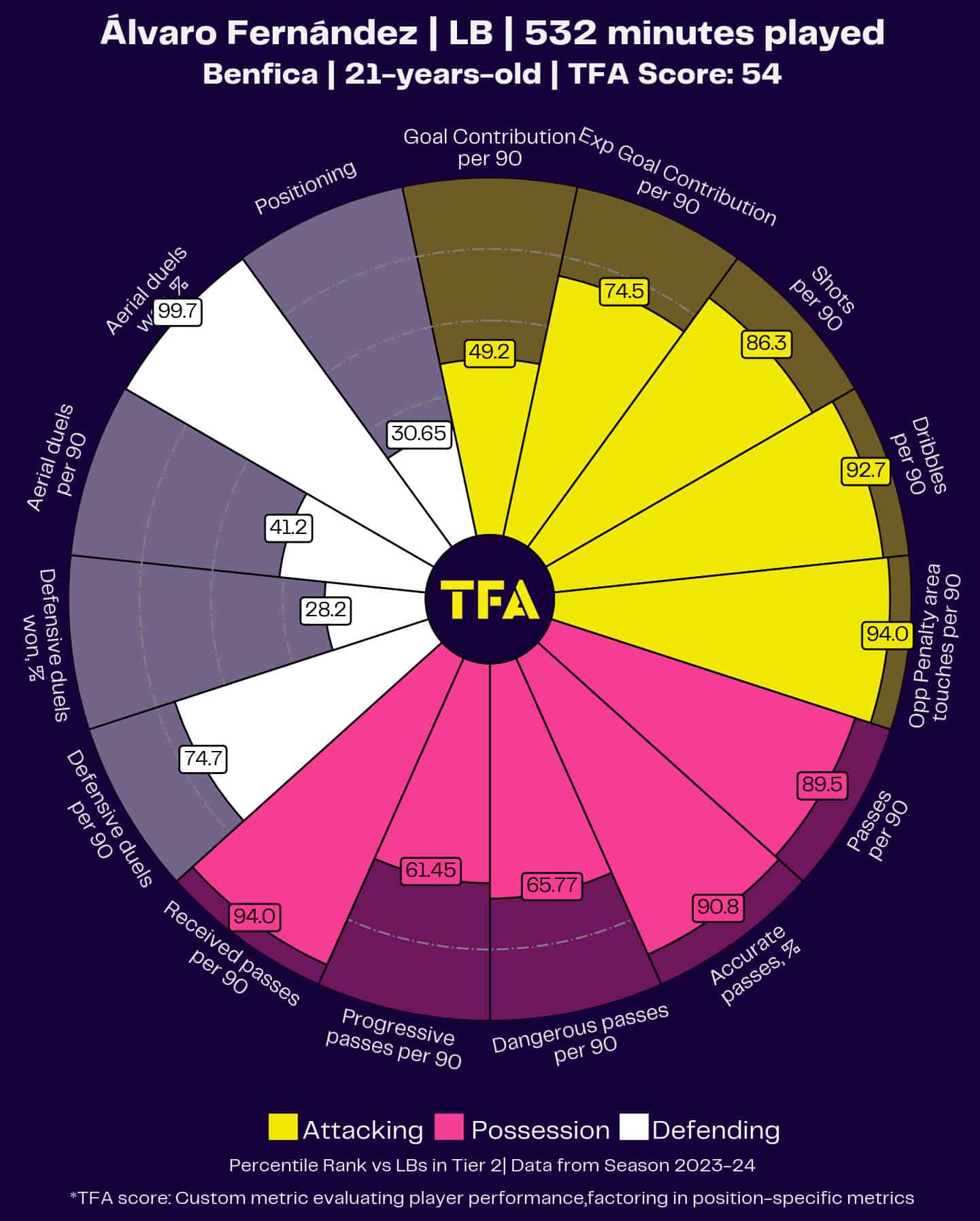
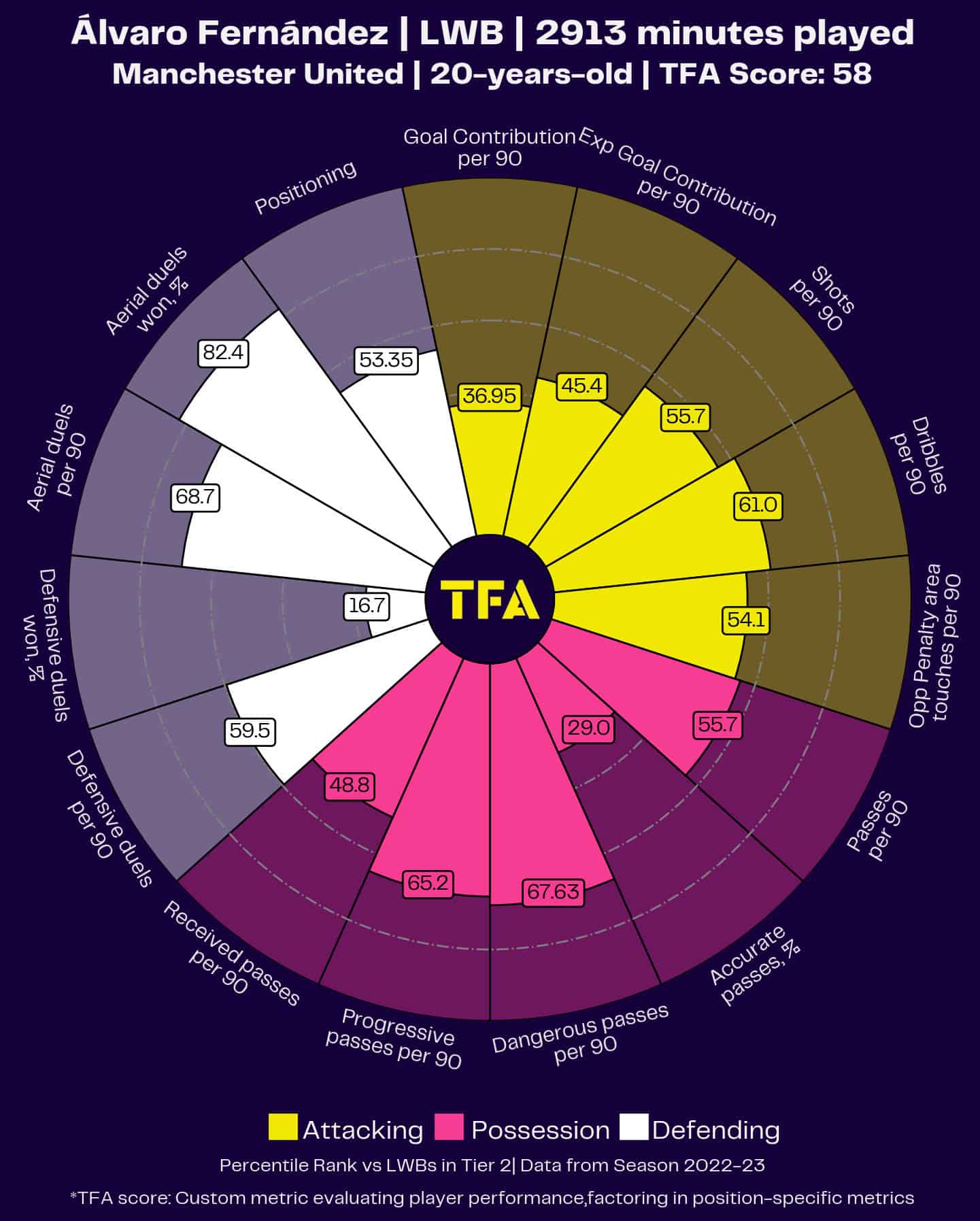
If we examine the data from his stints at Preston and Benfica, we can see a couple of interesting tendencies.
First of all, Carreras is very involved in the game.
He is playing and receiving a decent amount of passes and has been featured frequently in his team’s build-up.
For Benfica, he was very secure with the ball, ranking in the 91st percentile of accurate passes last season.
Still, Preston struggled immensely with the ball, which is not surprising for a 19-year-old making his first steps in professional football.
However, his passing ability always allowed him to progress the ball, ranking above average in progressive passes and dangerous passes for both Benfica and Preston.
Another thing that stands out is his high amount of defensive duels per 90 minutes, with a rather disappointing success rate.
Carreras throws himself into duels a lot and attempts a lot of tackling during the game, but he is barely able to win the ball for his team.
A very interesting tidbit is his aerial ability; he ranked near the top in terms of aerial duels won in per cent in his time with Benfica, a trend that has continued from his Preston days.
Carreras is one of the most aerially dominant full-backs in world football right now; he effectively uses his size and jumping reach.
His attacking output has also been decent, ranking near the top in terms of dribbles per 90 and above average in many attacking statistics.
Unfortunately, he is below average in the most important attacking statistic, namely goal contributions per 90 minutes.
Still, he is a very young player, and full-backs also tend to get more efficient with age.
Álvaro Carreras Physicality & Power
One thing that stands out about Álvaro Carreras when you first see him play is his size.
He is way bigger than full-backs usually are but has a rather slim build; he could grow into his body a tad more over the coming years.
His size and resulting physicality are among Carreras’s biggest strengths, not just showcased by his aerial dominance.
Carreras’s attacking output has been very good this season, averaging the second most crosses per 90 minutes in the league so far with a very decent success rate of 47.6%.
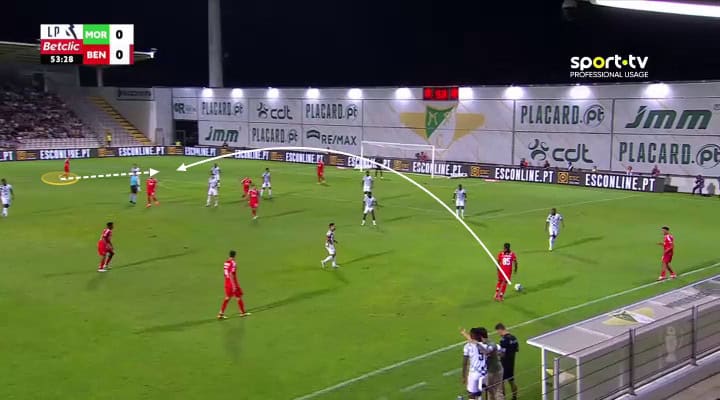
Here, we can see Carreras’ strength in its entirety.
Carreras is at the far side of the ball.
Realising that the right-back is not accounting for him, he moves into the penalty area.
Renato Sanches picks up his run and plays a long ball towards Carreras here.
Overall, Carreras is a very traditional full-back in terms of positioning and playstyle.
He likes to stay out wide behind a winger in front of him, making delayed runs into the penalty area and finding opportunities to cross the ball to his strikers in the box.
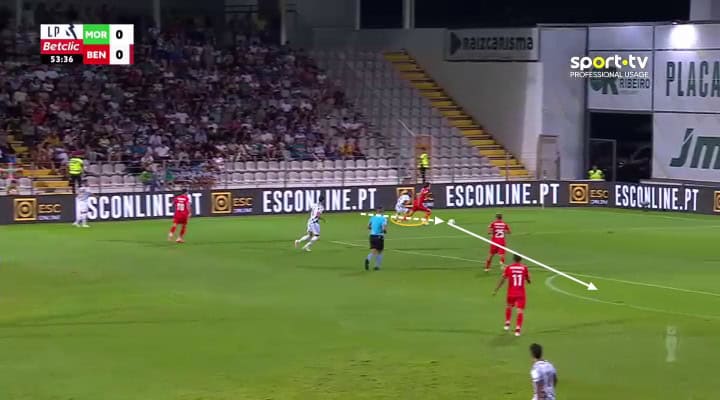
In this situation, Sanches plays a poor switch to Carreras, which leads to two attacking duels for the young left-back.
In this situation, he showcases his physicality and pace, powering through multiple defenders and crossing the ball into the box.
However, Carreras relies too much on his physicality while dribbling, which leads to a rather low success rate of 33,33% when taking on defenders this season.
His agility and balance are not bad, so there is a lot of untapped potential for him there, but he needs to work on his attacking 1v1 to succeed at the highest level.
His physicality is not only shown with the ball and in aerial duels — he also showcases it while defending.
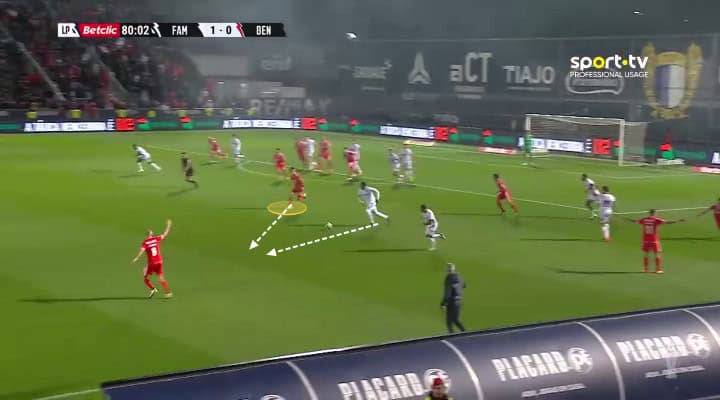
Here we can see the aftermath of a Benfica free-kick, ending up in a counterattack for Famalicao.
Carreras instantly reacts and moves backwards, trying to defend the counterattack with his face towards his own goal, which is always pretty tough for defenders.
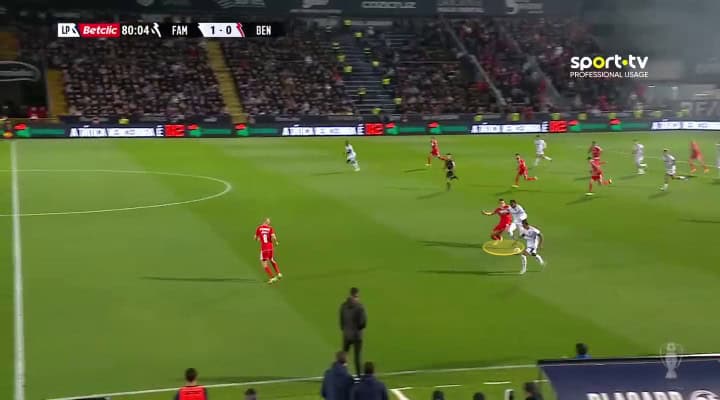
He uses his pace well to close the distance to the ball carrier quickly and uses his body well to slow him down.
After the physical duel, Carreras times his sliding tackling perfectly, playing away the ball from the attacker and stopping the counterattack quickly.
His combination of size and pace is very intriguing and helps in all phases of play.
Álvaro Carreras style of play lacks finesse in many situations, not just in his dribbling but also in his defending, but there is a clear path to development for him.
This season, he has been much better at defending.
He still attempts a lot of defensive duels and tackles per game, but his above-average success rate of 62.5% is a great improvement.
Carreras has learned to generate power with and without the ball through his physicality, which will help him during his career.
Álvaro Carreras Problems With The Ball
Benfica have struggled so far this season, leading to the dismissal of coach Roger Schmidt.
Their play in possession was one of the main reasons for this.
Unfortunately, Carreras has struggled on the ball this season, too.
Obviously, with the entire team struggling, you can’t really put a lot of blame on the 21-year-old full-back in his first full season at the club, but compared to last season, Carreras, unfortunately, could not further his development with the ball.
One thing he is struggling with is finding solutions in the passing game in the build-up for Benfica.
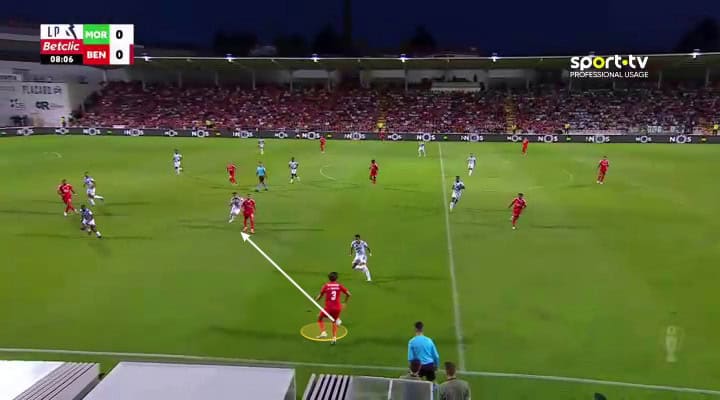
Carreras, once again, is a very traditional left-back here, receiving the ball out wide in a four-man-build-up for Benfica.
From here on, he needs to find solutions on his own.
Benfica are trying to create diamonds on the wing but they yet again struggle with it in this situation due to the timing.
Carreras is left with a bunch of bad passing options.
He could play it back into the press or heave it down the field towards his striker, but he tries to play the first-time pass into midfield, which ends up in a loss for Benfica.
Carreras struggles with pressure, and this situation is a perfect example.
After receiving the ball, Carreras is not under a lot of pressure.
Yes, the defender is closing him out, but realistically, Carreras could control the ball and move down the line himself instead of forcing a pass.
This decision-making is holding Carreras back right now.
While he is attempting the fourth most passes per 90 minutes for full-backs in Liga Portugal, his success rate of just below 72% is terrible and a deja vu of his time at Preston, where he also struggled with ball security.
Another problem he has is his efficiency, as we have highlighted in the data profile already.
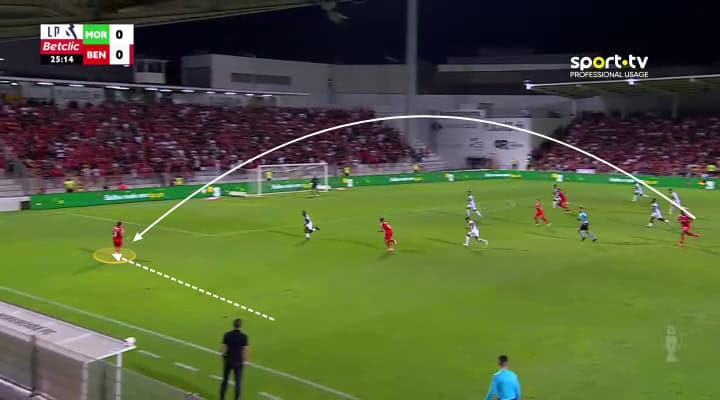
Once again, Carreras makes an excellent run to receive a switch from his midfielder.
His first touch is great, not just in this situation but overall, and he is able to cross the ball with his second touch.
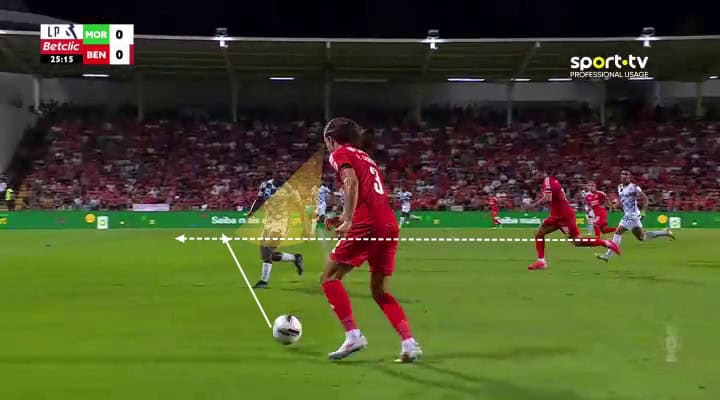
The problem in this situation is Carreras’ vision.
He is not looking into the middle of the field; he is just looking down at the ball, which means he cannot see his attackers’ runs in the box.
Therefore, his timing is off, and the cross can be defended by one of the Moreirense centre-halves, even though Benfica was in the driver’s seat in this case.
Overall, Carreras is a nice throwback full-back.
He is best out wide and uses his physicality, pace, and crossing ability well.
He struggles with passing and pressure a fair bit, and while he is very active during games, his actions lack finesse and timing, which is not surprising considering his age and his lack of experience.
Still, Álvaro Fernández Carreras already features as a starter for Benfica and possesses the potential to become a regular starter at the top level for teams that value a traditional full-back over modern ones.
Carreras definitely has a future as a left-back in a back-four, and his style of play would fit into the Premier League very well.
However, if he really wants to find success, his passing ability will need to improve.
While his playing style is very cool and a nice change of pace in today’s game, there is a reason why modern full-backs are usually great passers, and Carreras has a lot of work to do in that regard.
Martim Fernandes Scouting Report — The Most Complete Full-Back In Portugal?
For the second player on this list, we are going to switch sides and look at a young right-back, Martim Fernandes, who plays for FC Porto.
Unlike Carreras, Fernandes does not have an interesting past at multiple top-tier clubs; he joined FC Porto’s academy at age 11 and has remained loyal to his boyhood club.
Fernandes was a regular for Porto’s B-team in the second division of Portugal last season and also featured in the Youth League team that FC Porto fielded in the U19 competition.
During the last four games of the season, Martim Fernandes became the regular starter for FC Porto at the right-back position, and he has taken hold of the starting spot in the lineup this season as well, beating out João Mario for the spot at just 18 years of age.
Martim Fernandes In Possession
The moments Martim Fernandes shines the most are definitely the moments he has in possession.
Fernandes does not play like an 18-year-old; he plays like he has been at the top level for many years, showing great composure and maturity in most situations.
Martin Fernandes style of play has an excellent feel for space, always being able to exploit minor movement errors by the opposing team to find runs to threaten the defence.
He is also very calm on the ball, having a good first touch to keep his options open and is really secure with the ball on his feet.
He is able to keep his head up in pretty much every situation and finds passing channels in the build-up and final third to get his teammates involved.
He ranks second amongst full-backs in the league in terms of key passes per 90 minutes and has created multiple good scoring opportunities for Porto so far this season.
In the build-up, Porto drops back one midfielder out wide and lets the full-backs push up the field in a very high position, threatening the defence vertically.
Martim Fernandes is an integral part of this.
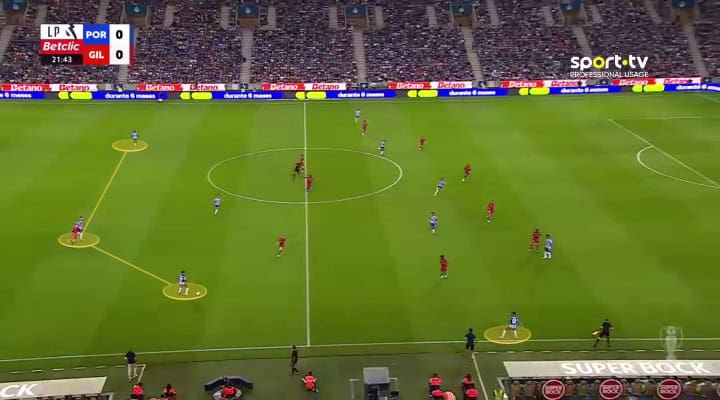
Here, we can see FC Porto in a three-man build-up, with Fernandes pushing up the field near the sideline.
Porto is overloading the right side of the field, forcing the defence to react to their movement.
Fernandes positions himself perfectly in between the lines in a half-open stance, ready to receive the ball and move forward with his first touch.
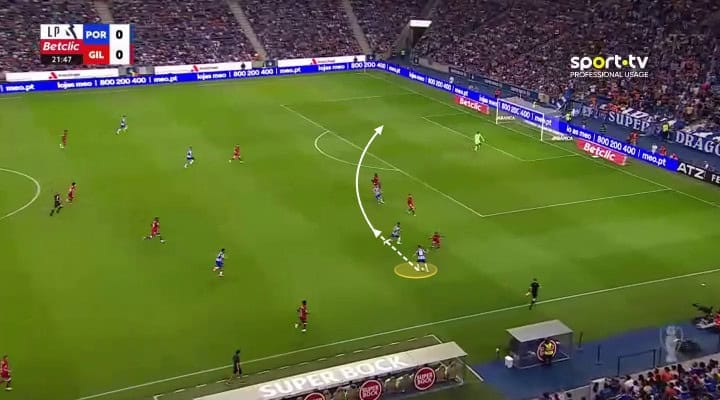
In this situation, Fernandes receives the ball and, because of the movement of the right winger, is able to control it easily.
The defence moves to its left because it has to push to the side of the ball, and Fernandes easily punishes that by moving into the centre of the field quickly, dribbling against the movement of the defence, which makes defending for them incredibly hard.
He then has multiple options but looks for the fastest way into the box, playing a great long ball out of the half-space onto the far post.
His teammates are offering him a run, but the Gil Vicente defender makes an exceptional play and somehow clears the ball with his head for a corner.
Martim Fernandes is great at noticing situations and movements around him.
He constantly keeps his head up and finds easy-to-execute solutions that allow his teammates to shine as well.
He can also receive the ball between the lines, and Fernandes can threaten the defence with runs in behind.
His acceleration and pace are very good, and his timing on these types of runs is nearly perfect, making it nearly impossible for opposing teams to defend.
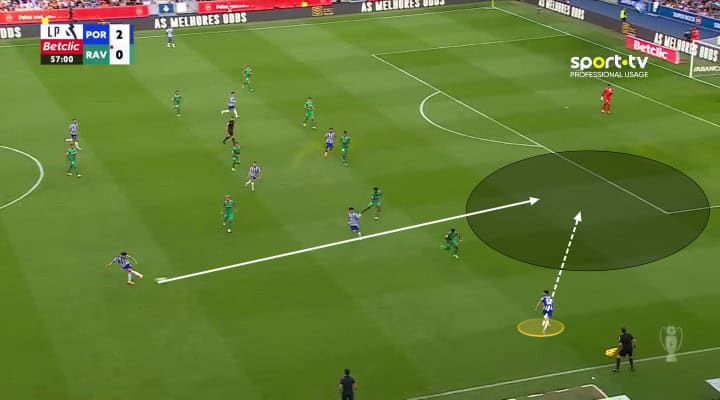
Here, Fernandes is out wide and up high as well, but he realises that the defenders will not be able to close out to him anyway.
He starts his run in behind the defence, exploiting the space the left centre-back left behind him by moving forward with the Porto attacker.
The ball is also played with perfect timing, but just a little bit too far from the outside.
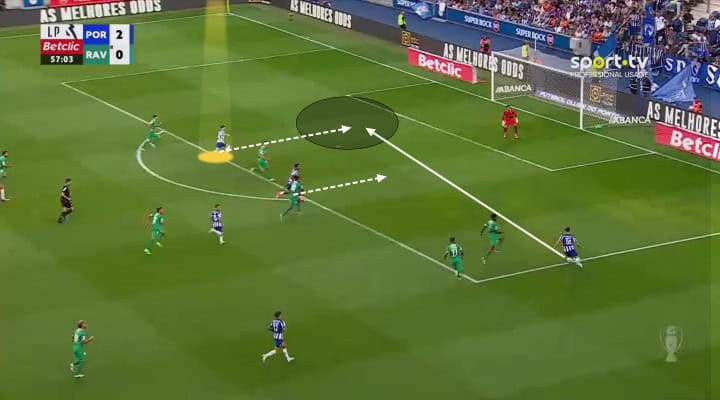
This does not prove to be a problem for Fernandes, as he just adjusts his body position and still easily gets to the ball fastest.
During the run, he constantly keeps his head up, scanning the box for opportunities.
This allows him to play the first-time cross to the far post, where his striker is moving into open space.
While the striker fails to convert the opportunity, Fernandes did everything right in this situation, and that is just the norm for him rather than the exception.
Martim Fernandes Out Of Possession
Another thing full-backs need to be good at, obviously, is defending.
While Martim Fernandes definitely shines in possession, he is very sound against the ball as well.
He still lacks some physicality, which leads to him being muscled off the ball in duels a lot right now, but technically, there is not a lot that he can do better than he is doing right now, even though he is only winning 50% of his defensive duels and only 33.33% of his aerial duels.
Martim Fernandes likes to defend very forward. While he is not great at direct duels, he has an amazing defensive footballing IQ and showcases that a lot.
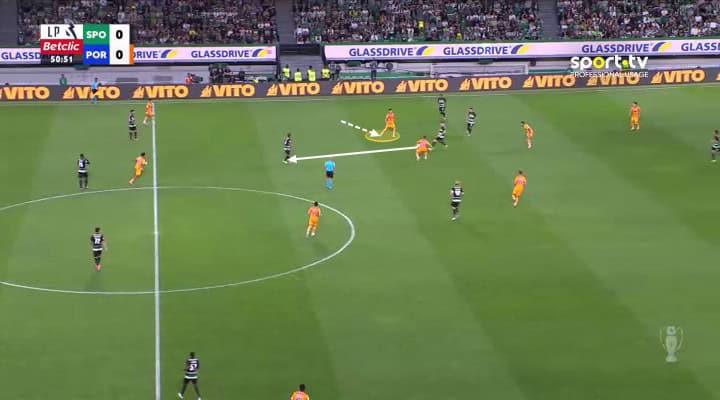
Here, Fernandes lost the ball after a bad pass by one of his centre-backs.
He quickly scans the field around him, realises he is in a 2v4 situation, and condenses the space for the Sporting midfield.
This forces the Sporting player to move the ball out towards his left winger because Fernandes quickly applied one of the basic defences of defending and secured the centre of the field within just a second.
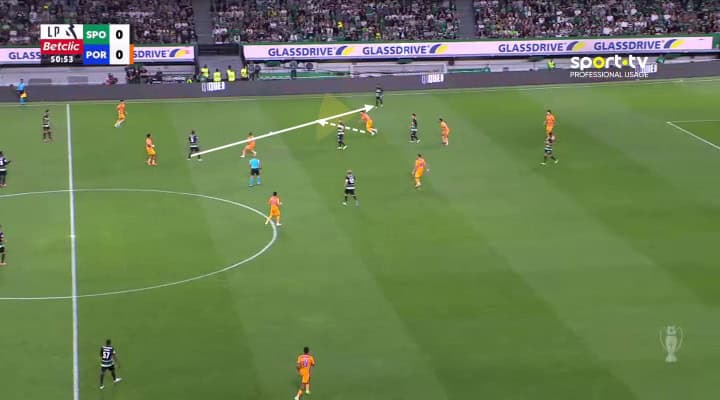
Fernandes does not trot back to his position; however, even after not winning the ball with their first wave of counter-pressing, he still wants to actively recover the ball quickly.
He looks downfield, reads the body movement of the Sporting player, and defends on his front foot.
He quickly moves forward into the passing lane, intercepts the pass, and secures possession for his team.
Again, Fernandes was forced into a series of snapshot decisions in this situation and managed to recover the ball due to his great understanding of the situation.
This once again showcases his maturity and calmness, which are impressive for only his 11th game at the top level.
If we are talking about his defensive duels, Martim Fernandes is not quite there yet in terms of the physicality needed in the grown-up game, but he has elite footwork and a good pace to help him in these situations.
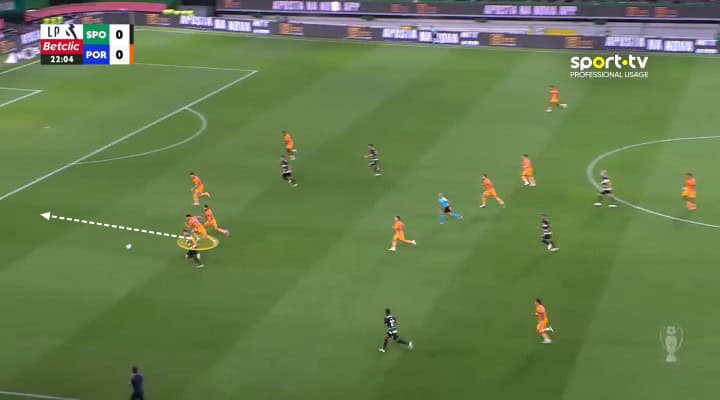
Here, Viktor Gyökeres, the most prolific attacking player in Liga Portugal right now, has managed to get past Fernandes in the first instance.
Instantly, Fernandes uses his pace to follow Gyökeres, and he once again makes a good decision by cutting off the middle of the field for the Swedish striker, forcing him to drop off the pace.
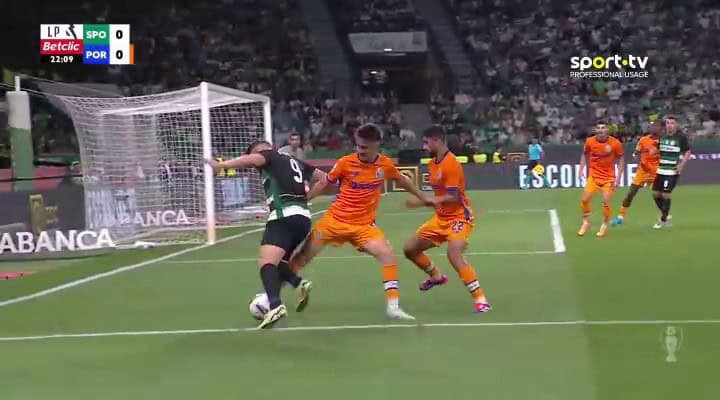
From there on, Porto is double-teaming the attacker, and Martim Fernandes does two things in perfect execution.
Firstly, he understands his leverage extremely well, which means that Fernandes understands that Gyökeres can only move towards the baseline with the help of his teammate and removes that option as well.
Secondly, his footwork is elite in this situation.
He moves very light-footed and takes many quick lateral steps, which allow him to keep his balance and react to the Swedish attacker’s acceleration.
This makes him able to defend the take-on attempt really well.
While Fernandes struggles physically right now, his technical defending is as sound as it gets, and that is way more important at the top level.
To sum up, Martim Fernandes is the prototype of a modern full-back; he is great in possession and at moving forward, providing a lot of attacking output for his team.
He also stays calm under pressure and constantly makes good decisions with and without the ball, timing his actions well and being a reliable option for his coach in all four phases of play.
He struggles with physicality at the moment and, therefore, loses a bit too many defensive duels, but his technical ability while defending and his defensive footballing IQ are great.
If he manages to grow a bit stronger, he will be an elite defender as well.
Considering what most top teams are currently looking for in a full-back, Martim Fernandes will have an exciting career path in front of him.
Geovany Quenda Scouting Report – An Inverse Wing-Back?
The last player we are
examining today is Geovany Quenda, who is very interestingfor several reasons.
The first reason is relatively simple: Quenda was born in 2007 and only turned 17 at the end of April, which makes him the youngest player in Liga Portugal this season.
He is one year younger than his two closest peers, Martim Fernandes and Gianluca Prestianni, yet Quenda is still the starting right wing-back for the best team in the league.
The second reason Quenda is an exciting player is that he plays as a right-wing-back but is left-footed, making him a rare inverse right-back.
There are a couple of right-footed left-backs, like Philipp Mwene for example, but a left-footed right-back is something like a unicorn in world football right now.
The final reason Quenda is interesting, and a couple of you are probably wondering why he is even on the list, is that, technically, he isn’t a full-back.
Quenda currently plays as a full-back in Ruben Amorim’s 3-4-3 formation, but until last season, he played exclusively as a winger in Sporting’s academy teams.
So now, we will try to examine the Unicorn of world football.
Geovany Quenda Attacking Power
With his background, it’s pretty evident that Geovany Quenda style of play is an attacking type of full-back.
He likes to receive the ball out wide, instantly pick up the pace, and force defenders into 1v1 situations, where he can use his incredible pace and agility to win duels for his team.
His 5.9 successful attacking actions per 90 minutes rank first in the league for full-backs, and his 6.41 dribbles per 90 minutes do the same.
What’s even more impressive is that two-thirds of his attempted dribbles are successful, which is insanely efficient for this large sample size.
Quenda is also ranking fourth in progressive runs per 90 minutes and offensive duels won per 90 minutes, once again confirming that, at 17 years of age, he is already one of the best-attacking full-backs in the league.
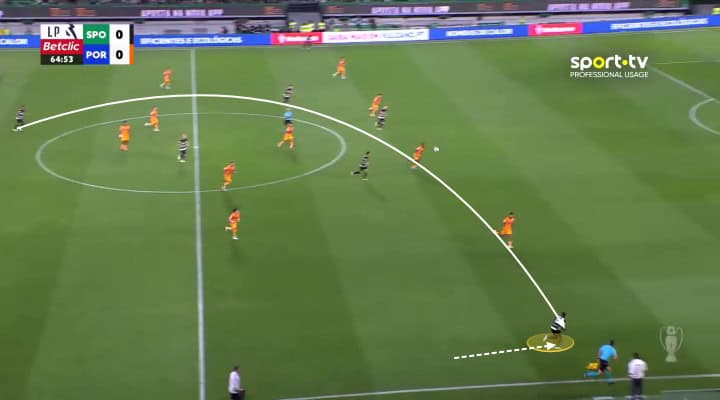
Here, we can see a typical situation for Sporting this season: the team is overloading the left side of the pitch, isolating Quenda out wide on the right-hand side.
This enables them to play a switch to their youngster, releasing him into space and a 1v1 situation.
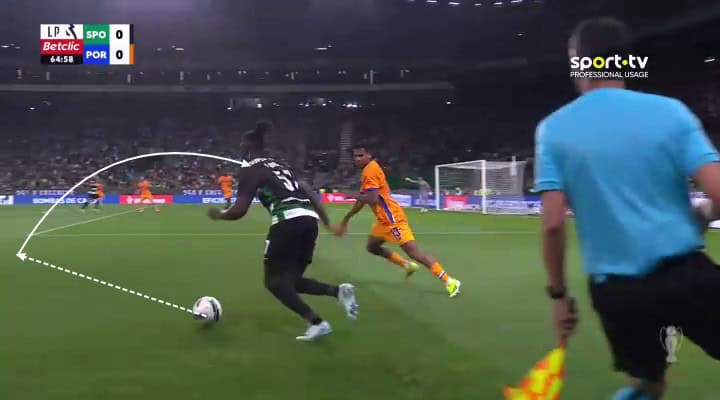
Here, Quenda is able to turn in Galeno and get past him with ease.
In this situation, we can see why it’s interesting that he is left-footed: he can turn to the inside and play a cross towards the far post, curling inwards, making it incredibly hard to defend.
In these situations, Sporting makes it nearly impossible to defend an opposing defender in a 1v1 against Quenda, one of the fastest and most agile players I have seen in a long time.
This means that Quenda can use his strengths very effectively to help his team and keep defences on their back foot.
Another interesting thing about Quenda’s left-footedness is his ability to open up play within an instant of receiving the ball.
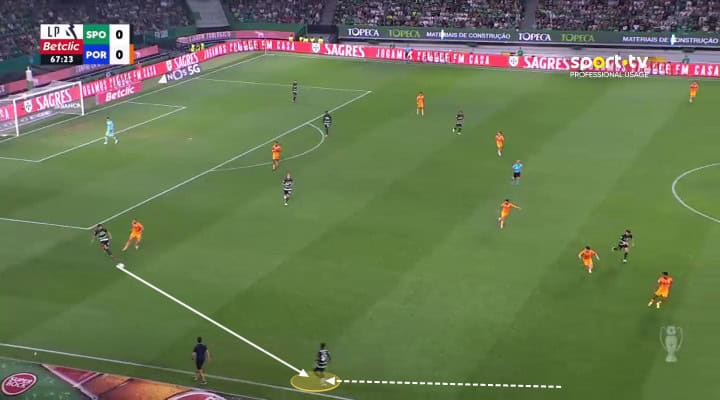
Here, Quenda is dropping back deep, receiving the ball from his centre-back in open space.
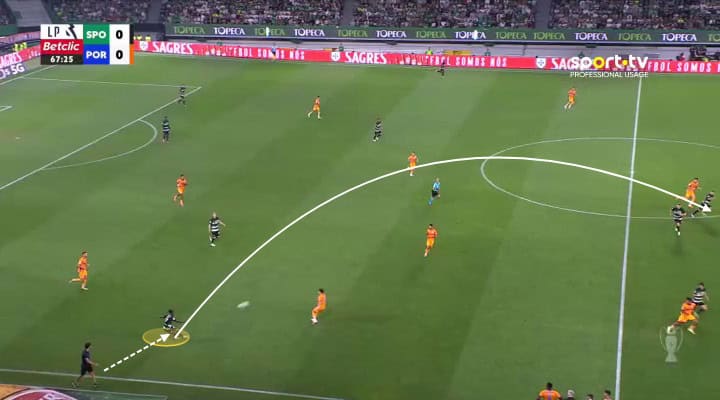
Before the Porto defender can even react, Quenda is turning towards the middle of the field.
For any other right wing-back, the ball would now be on his weaker left foot, limiting the options, but for Geovany Quenda, the ball is now right where he wants it to be.
This catches Porto off guard in this instance, allowing Quenda to play a long ball behind Porto’s defensive line, which they are barely able to defend against rapid Viktor Gyökeres.
While it sometimes limits Quenda as well, when he needs to play balls down the line, pressing him is really hard because he can open up towards the centre of the pitch while shielding the ball, opening up the passing game for him, something that right-footers can not do in this capacity.
It’s interesting to see that many teams are struggling to remove this option from him while keeping their press compact.
It definitely helps Sporting against some teams, like it did against Porto.
This also shows up in the statistics, with Quenda completing 83.76% of his passes, a very decent amount for a young player making his first five appearances at this level.
While his passing is very accurate, his crossing is not, with just 30% accuracy; his success rate with crosses is one of the worst in the league.
Geovany Quenda Counterpressing
While his background enables him in the attacking phase of play, it sometimes holds him back defensively.
However, Sporting is simply dominating the league, being far ahead of the competition in nearly every game, even against FC Porto on the last matchday before the international break.
This means that in most games, opposing teams are not even able to challenge Quenda on his right defensive side because they are suffocated by Sporting’s overall play.
He obviously struggles with physicality, winning only 54% of his defensive duels and 20% of his aerial duels, but he has not been completely in over his head so far this season.
In fact, he even had some really good scenes in pressing, especially counter-pressing, and we are going to take a look at one of them.
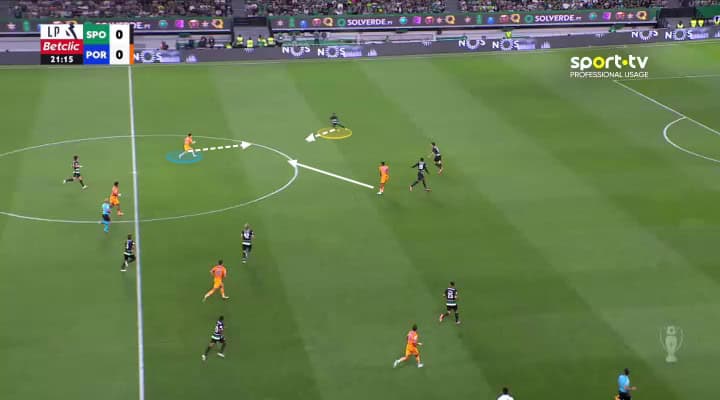
Here, Porto plays a long ball and tries to play a layoff to the midfielders, the pass is really bad though.
Quenda realises this and is the first to react to put pressure on the Porto player.
He uses his pace to get to the ball quickly and not allow the Porto player to move forward towards the goal.
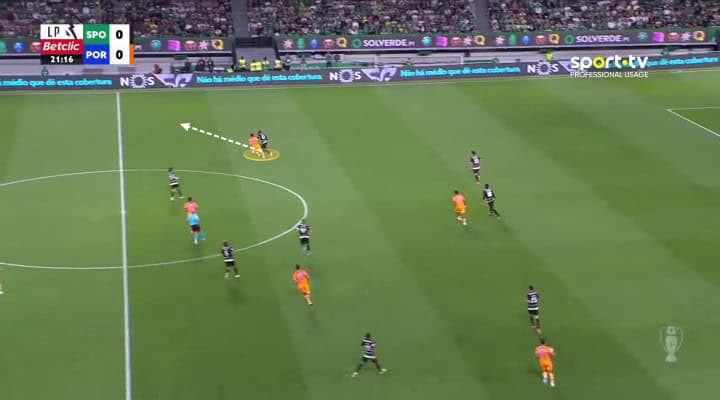
He then shields the ball extremely well with his body and takes off, leaving the Porto attackers in the dust and not even allowing them to counter-press.
Here, we can see that Quenda has the potential to become a very solid defender because he uses his physical gifts very well, and his reaction times are simply amazing, even compared to other players at Sporting or Porto.
It will be really interesting to see how this season is going to play out for Geovany Quenda.
His potential is obvious.
His pace and technique are incredible, and he is one of the best players in the league at just 17 years old.
However, Sporting needs to fix a couple of flaws with him—his weak foot needs some major work, and his first touch is not consistent enough yet.
There will be two significant factors that will determine the outcome of Quenda’s career:
Firstly, will he be able to become a solid defender? He flashes some potential, especially in the press and counter-press, but will he be able to defend 1v1 situations and improve his aerial ability at some point?
Secondly, will he get more efficient moving forward? He is very young right now, which is why it is expected that he lacks efficiency, but if he wants to take the next step, he will need to.
I really hope that Quenda can improve over the next couple of years because I really want to see a left-footed right-back at the international top level, to see how coaches would use him.
So far, this season has been great for him and he has even earned himself a call-up for the Portuguese national team.
Conclusion
This year might be the year of the full-back in Liga Portugal.
With Álvaro Carreras, Benfica managed to sign a very talented throwback left-back whose biggest strengths lie in his physicality and pace.
However, Carreras struggles with the ball, which will determine if he can take the next step.
With his physical gifts, pace, and willingness to do the dirty work, he will eventually carve out a nice role for himself in world football.
Martim Fernandes might be the prototype of what coaches want in modern full-backs.
The 18-year-old right-back plays like he has been playing at the top level for years, making the right decision in nearly every situation and enabling himself and his teammates to achieve greatness.
However, he struggles with physicality and needs to improve his defensive duels; otherwise, it will be hard for him to move into a bigger league.
Lastly, Geovany Quenda is a unicorn at the right wingback position, being the only left-footed player playing this position right now.
At just 17 years of age, the Portuguese international has had an impressive start to the season.
His pace and agility have even surprised the majority of coaches in Liga Portugal.
However, he needs to work on his defending and offensive efficiency.
Otherwise, it will be hard for him to advance to the big stage of Champions League football.
For all three of the players, their debut on the international stage is upcoming.
Will they face this challenge as well or will they fall under the pressure at their young age?
It will be really interesting to follow the careers of those three young standouts in Portugal.






Comments